Welcome to today's course, Cutting the Wire Part II: Fitting Wireless CROS and BiCROS Devices in Practice. This is the second in a two-part course covering wireless technologies for CROS and BiCROS hearing aids. Part I of this course, Cutting the Wire, What's New in CROS/BiCROS Technology? discussed the technological aspects of the hearing system, while this part will discuss the practical fitting aspects of CROS and BiCROS devices. For a review, Part I can be viewed here or read here.
Today we will provide a short summary on single-sided deafness and the consequences it has for patients. Then we will go through the CROS concept from indications to candidacy for CROS and BiCROS fittings. Next, we will concentrate on the fitting process for CROS/BiCROS devices, including verification strategies to ensure the best performance from these devices.
Single-Sided Deafness
Single-sided deafness describes one deaf or unaidable ear with normal or near-normal hearing in the other ear. Unaidable means at least a severe to profound loss and poor speech intelligibility at that ear. If there is a person speaking to the deaf ear, the sound travels around the head, and the good ear is in the shadow of the head. This head-shadow effect attenuates sound by approximately 6.5 dB, depending on the frequency. This results in poor speech intelligibility. This listening scenario can get even worse if we add a noise source to the better-hearing side. The signal-to-noise ratio decreases in steady noise, making speech intelligibility increasingly more difficult for the listener.
Many people with single-sided deafness do not think they have a hearing loss because they have a near-normal loudness perception in many listening environments with their good ear. Furthermore, many of these patients do not believe that they are candidates for hearing instruments, yet they still have problems in noisy and spatial situations. Typically, successful listening in spatial situations requires two more or less equal ears, since then our brain can make use of the interaural time delays and intensity differences between the two ears (binaural hearing). With an impaired ear, one cannot make use of those cues important for spatial hearing.
The concept to solve this dilemma is called CROS (contralateral routing of signal). If we take the situation where the speaker is on the deaf side, a CROS aid will pick up the signal at the deaf side and then route it contralaterally to the better ear. This will improve performance, especially in situations where noise is placed on the side of the good ear because it will amplify the speaker's voice to a near-normal level. A microphone is worn on the deaf side, and the sound received on this side is transmitted to the good ear with either a wired connection or wireless transmission as in the audifon via products. If the good ear also has a hearing loss and needs amplification, we might add a second microphone on that ear. The hearing aid configuration where we have one microphone on the deaf ear and an additional microphone on the better ear is called BiCROS (bilateral contralateral routing of signal). Signals are picked up on both sides and amplified accordingly to the hearing loss and delivered to the better ear.
The latest development is to digitally transmit signals from one side of the head to the other. The most advanced technology to accomplish this is through near-field magnetic induction (NFMI). This technology enables a wide bandwidth and high audio quality with very low power consumption. The benefits of digital high-frequency transmission mean that no cables or direct audio input connectors are required.
The devices are available in behind-the-ear (BTE) or in-the-ear (ITE) styles. audifon's CROS and BiCROS products have superior sound quality because of the digital high-frequency transmission. These amplification systems also use the latest binaural benefits such as synchronization of volume and program changes. The systems can be paired with an encrypted transmission so there is no interference with other systems in the same room. Because of the low radiation power, manufacturers do not have to undergo regulatory affairs for the wireless link, and the systems can be used worldwide. This might be beneficial, e.g., for international travelers. Digital signal processing, however, causes a slight time delay, which can be compensated in the audifon via products by using the sound resync feature.
We expect a CROS or BiCROS fitting to eliminate the head-shadow effect. The main benefit is an improved signal-to-noise ratio at the good ear. Even if speech and noise at opposing ears are at the same level, overlaying the sounds can cause subtle differences for a more enriched and "stereo" listening experience. Some patients fitted with a CROS or BiCROS report improved directional hearing, although they are still only hearing with one ear. We call this the pseudo-stereophony. Subtle sound differences or changing directions can be used to improve spatial hearing. CROS fittings provide improved speech intelligibility in noisy listening situations, especially when speech is directed at the poorer ear.
Indications for CROS and BiCROS Fittings
At a glance, indications for fitting a CROS include at least a severe to profound hearing loss in the poorer ear that cannot be fit with a hearing aid. Additionally, there may be medical contraindications that preclude a conventional hearing instrument on that side. These effects have the obvious consequence of very poor speech intelligibility. Hearing on the opposite ear must be good enough to not meet the criteria for a hearing aid.
Candidacy for a BiCROS is similar to a CROS fitting, where there is profound hearing loss in the poorer ear. The better ear should have a mild to moderate hearing loss that can be fit adequately with conventional amplification. The success of the BiCROS fitting is dependent on the status of the hearing in the better ear. At the least, we can expect a good unilateral fitting on the better ear.
The goals for a BiCROS fitting are basically not different from those of a CROS fitting. However, the fitting strategies will be different. A BiCROS fitting is a combination of a unilateral fitting with an additional CROS configuration. First, the target gain on the better side will be the same target gain if you were to fit the hearing aid as a unilateral fitting only. No corrections for bilateral fittings, such as gain reduction, should be applied. The user must have good performance with the hearing aid function in the better ear alone, so high quality devices are essential.
We first must compensate the microphone configuration on the better side depending on whether the transmitter is an ITE or BTE device, (microphone location effect). In an ITE configuration, the microphone will be located within the ear canal and will use the resonances of the open ear. If you have a BTE configuration, the microphone is located on the top of the ear, resulting in changes to the acoustic properties of sound as well. These are microphone effects which we have to compensate. Furthermore, we have to consider overcoming the head-shadow effect, and this is accomplished by transmitting the signal to the better side. CROS or BiCROS configurations nowadays typically consist of an open-fit BTE, but if an earmold is used, the venting, length and tubing characteristics must be taken into account also. In BiCROS fittings we follow the same three steps as a CROS fitting. However, the hearing loss on the "better" ear must be compensated additionally.
In CROS fittings, the sound should not be amplified, but rather only be transferred to the better ear. The overall transfer function for frontal sound must simulate the sound path to the normal ear. In other words, the real-ear aided response (REAR) on the poorer ear should equal the real-ear unaided response (REUR) of the better ear. The REUR in a normal-hearing ear not occluded by a device or earmold is also called open-ear gain (OEG). So the transfer function from the poorer ear to the tympanic membrane of the good ear must simulate a normal open-ear gain, and the characteristics of the good ear should not be changed. This is an advantage of open fittings.
If we apply significant amplification to the sound in a CROS fitting, disadvantages can outweigh the advantages. If we made the poorer ear better than the good ear by providing over-amplification, the end result would still be one ear that is hearing better than the other, so we have not changed the initial situation at all, but only reversed "better" and "poorer" side. So over-amplification must be avoided; a good balance between the two ears is the goal. If there is too much gain in the low frequencies, performance can be reduced when speech comes from the better side. When speech is on the better side and noise is on the poorer side, too much amplification emphasizes the low frequencies causing an upward masking effect. By using an open-ear configuration on the better side, low frequencies will not transfer as well, and the masking effect is no longer a problem. In BiCROS fittings, gain reductions are not needed to compensate for binaural loudness summation.
Verification of CROS and BiCROS fittings
Verification can be done at several levels. As with other amplification devices, the acoustical characteristics of the CROS can be checked. We can measure performance of the instruments in a test-box coupler or through rear-ear measurements. Because open fittings are not easily measured in a test box, I would strongly recommend using real-ear measurements.
Speech perception should be tested using appropriate test materials designed for speech tests in noise. The main goal of CROS and BiCROS fittings is to improve speech intelligibility in noise. If speech tests are not available, you could use loudness scaling (see below). We can test everyday subjective performance by asking the client about his experiences and preferences in different listening situations. This can be accomplished systematically by using questionnaires such as the Client Oriented Scale of Improvement (COSI; Dillon, James & Ginis, 1997) and the Abbreviated Profile of Hearing Aid Benefit (APHAB; Cox & Alexander, 1995). I would recommend using questionnaires backed by significant evidence.
Estimating Coupler Response
We start with the assumption that the real-ear aided gain (REAG) at the poor ear should simulate the performance of the open, un-occluded better ear. The REUG should be just the open-ear gain. We first have to consider the microphone-location effect at the poor ear. The hearing aid is placed on the better ear. Then, of course, we have the real-ear-to-coupler difference (RECD) transforming real-ear curves to coupler curves. The coupler response is then the REUG - RECD - microphone-location effect - hearing aid/ear mold configuration at the better ear.
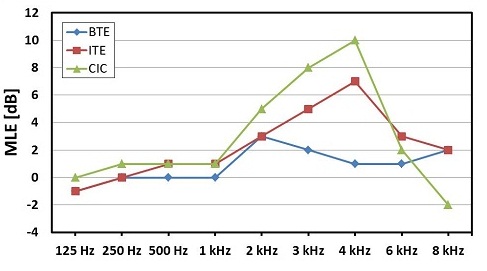
Figure 1. Microphone location effects in dB for BTE, ITE and CIC hearing aids across frequencies (data adapted from Dillon, 2001).
A BTE configuration provides a small amount of amplification to the high frequencies, due to head diffraction effects. When the hearing aid microphone is seated deeper into the ear canal, as in an ITE or CIC fitting, the high frequencies are emphasized, like in the "normal" open-ear. When you consider the microphone-location effect and head-shadow effect and put it together in a coupler, we will end up with coupler output responses shown in Figure 2.
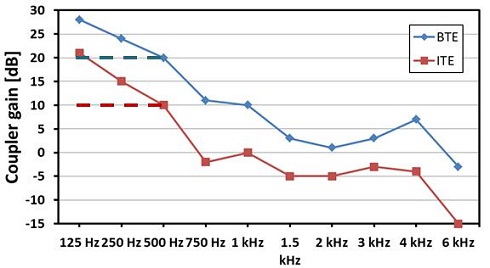
Figure 2. Comparison in coupler gain between BTE and ITE instruments across frequencies (data adapted from Dillon, 2001).
We can see an essentially flat configuration because we assumed a BTE configuration at the microphone side. Notice the low-frequency increase in gain (Figure 2); this is the compensation for a large vent (approximately 2 mm) at the better ear side, which is not delivering low frequencies. In an actual fitting you will not apply so much gain in the low frequencies. The gain should be kept at the value for 500 Hz (as indicated by the dashed lines in Figure 2). For an ITE device on the better side, the coupler gain is lower due to the lower residual volume we have in ITE configurations. Keep in mind that you should use the ITE coupler for verification, which is also smaller in volume than the BTE coupler. As in any fitting, coupler gain proposals provide a pre-fitting of the devices, but those fittings should be modified if there is a need to fine tune based on the demands of the client. As previously stated, coupler measurements can be difficult to obtain with open configurations, so the audiologist may feel more comfortable using real-ear measurements.
Real-Ear Measurements
If you want to verify a CROS system using real-ear measurements, we first must prove and verify that the open ear gain in the better ear will not be modified significantly by the CROS device. Place the CROS device on the ear in the off-position. Next, place the speaker towards the good ear with the probe microphone in the good ear. The reference microphone must always be on the side of the speaker. Measure the open ear gain. Assuming the CROS is a relatively open fitting, only few adjustments, if any, should be necessary to achieve a "normal" OEG.
After measuring the open-ear gain, we have to measure the transfer function of the CROS device, which is the REAG in the poorer ear. The probe microphone will stay in the better ear because we want to measure the system performance at the better ear. The loudspeaker is now placed towards the poorer ear, with the reference microphone on the poorer side as well. This can be problematic because this will require a real-ear unit with two independent microphones. If you do not have this setup, you will be unable to measure both sides simultaneously, so you have to use the substitution method where you first measure the spectrum of the loudspeaker and then use the probe microphone to measure the opposite side. The reference microphone must always be on the side of the loudspeaker.
Now measure the aided gain, which should look like an open-ear gain. We can easily measure open-ear gain at the good ear by switching off the device, but it is not as easy to measure the performance of the poor ear because the stimulus always will "leak" into the better ear, which cannot be switched off. It can be a challenge to measure with the loudspeaker at the deaf ear. However, we can test overall performance by making a third measurement with the loudspeaker placed at the front, assuming that most signals of interest are coming from the front. In this arrangement, both ears should contribute the same open-ear gain. We should see the same curve binaurally with perhaps a slight gain increase from the binaural summation.
If you verify a BiCROS using real-ear measurements, step one is the verification of the fitting of the hearing aid on the better hearing ear. To make the measurement, switch off the CROS part of the device and only use the hearing aid. Measure the REAG at the better ear with the CROS microphone switched off. The probe microphone, loudspeaker and reference microphone are all placed at the better ear. Take the open REAG measurement and, if necessary, make fine tuning and adjustments to the hearing aid side.
Next, switch on the CROS function and make a control measurement with the loudspeaker from the front with the probe microphone in and the reference microphone at the better ear. We cannot measure the CROS by placing the loudspeaker to the poorer side; we can only use the loudspeaker from the front. The reason is that in a BiCROS configuration, the loudspeaker signal will be picked up both by the hearing aid microphone and the CROS microphone. If the loudspeaker is moved to one of the sides, phase differences may occur due to the time delay. This phase difference can physically change the frequency response. Therefore, we only can check the entire system by applying sound from the front, and making sure the REAG does not change switching on the CROS configuration and is appropriate to the hearing loss on the BiCROS side.
Speech Perception
The main goal of CROS and BiCROS fittings is to improve speech intelligibility in noise, so it makes sense to measure speech perception in noise as well. You will need a two-channel audiometer and soundfield configuration where the two loudspeakers are on the right and the left sides, respectively. An angle of plus and minus 45 degrees relative to the frontal direction is recommended so that there is a 90-degree angle between the two loudspeakers. The exact position of the loudspeakers is not very critical in this particular case, but it should not be a configuration where the two loudspeakers are exactly at the front and at the back of the listener. This configuration is not suitable to measure the benefit of a CROS configuration.
The speech should be directed to the poorer side, and noise should be somewhere on the better side. This is the situation in which we would expect the best results. You will administer two speech tests in noise. The first measurement will be performed unaided, with the device in place but turned off. The second measurement will be made with the transmitter switched on, so the CROS or BiCROS function will be active.
As mentioned previously, the head-shadow effect will typically attenuate the speech signal by about 6 dB. A well-fitted CROS configuration will make up that difference and amplify by about 6 dB. We therefore could expect an improvement of the speech reception threshold of about 6 dB if we have a well-fitted CROS or BiCROS device; this is a significant benefit in terms of signal-to-noise ratio, and in real life it should bring a dramatic improvement in speech recognition. Speech-in-noise tests must be appropriate to the patient's age and native language.
Loudness scaling
In addition to speech perception measures, loudness scaling can be used to provide insight into individual fitting characteristics. This measurement is appropriate to check gain settings, especially in a BiCROS configuration. Loudness scaling is a method where we are not only measuring the hearing threshold of the sound, but the whole dynamic range of hearing by presenting signals at different intensities across the dynamic range and different frequencies across the frequency range, which should be randomized in order to avoid direct comparisons from one sample to the next. After each presentation of sound, subjects must rate the loudness of the sound they heard according to a loudness category scale such as "not heard, very soft, soft, medium, loud, very loud, and extremely loud" (see fig. 3). Some machines or examiners will use a number scale from 0 to 10 or 0 to 50. The end result is a loudness growth function.
The 50-point category scale can be graphed easily over the presentation level (Figure 3). The green line indicates the loudness growth function of a normal hearing person. Soft signals are barely audible at 0 dB and the loudness is rated at "0" (bottom left corner of the graph (Figure 3)). When signal intensity is increased, the loudness perception will also grow until it reaches a signal rating of very loud or extremely loud, or closer to the 50-point end of the scale.
The loudness growth function of a person with a conductive hearing loss is depicted in red. The line basically shifts to the right, but shows the same trend. Sounds at levels below approx. 40 dB are inaudible due to the hearing loss. Loudness growth for a person with conductive hearing loss will parallel that of a normal-hearing individual (Figure 3).
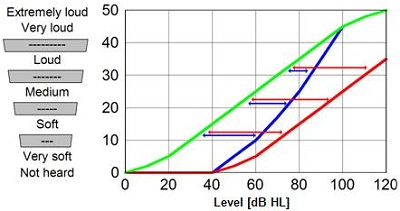
Figure 3. Loudness scaling, graphically represented for a person with normal hearing (green), conductive hearing loss (red), and sensorineural hearing loss (blue).
A sensorineural hearing loss is represented in blue (Figure 3). The loudness growth function for this patient is steeper and catches up with the normal hearing curve at the upper limit of loudness. This increased steepness is an indicator for what is called recruitment. The threshold is shifted for soft sounds but loud sounds are heard more similarly to the normal curve. We can derive gain settings from these curves by considering the distance between the curves. The small arrows indicate the amount of amplification that is needed to normalize loudness for the different input levels.
You could perform loudness measurements in both aided and unaided conditions. The unaided curve will fall somewhere between the green and red curves; the aided curve should be restored as close to the normal curve as possible. More information about loudness scaling can be found in the ISO 16832 Standard "Acoustics - loudness scaling by means of categories" (2006). There are additional resources on the administration of the test and interpretation of the results in this document.
Questionnaires
Questionnaires are a useful method to assess subjective performance of CROS and BiCROS fittings in everyday life. You could also interview your patient, but from a systematic perspective, using questionnaires is recommended. One well-established questionnaire is the Client Oriented Scale of Improvement (COSI; Dillon, James, & Ginis, 1997). With this questionnaire, the clients can indicate the most important listening situations where they would like some help. This gives a list of individual situations with priority rankings. Then, at the post-fitting appointments, patients are asked about the degree of change and whether performance in those scenarios got better. The goal, of course, is that the patient's perception of these conditions improves using the hearing aid. The patient can rate their final ability, so there is an indicator as to whether the negative issues were resolved or if there might still be room for other improvements. This is a good tool to individually compare the pre-fitting situation post-fitting. A disadvantage of such an "open" questionnaire is that you cannot compare the data with reference data from larger populations or different age groups. If this is what you are looking for, it is better to use a "closed" questionnaire, such as the Abbreviated Profile of Hearing Aid Benefit (APHAB; Cox & Alexander, 1995).
The APHAB asks for a number of different listening situations covering four different fields: ease of communication, background noise, reverberation, and aversiveness of sounds. All questions are answered for the situation without the CROS and then again in the post-fitting condition with the hearing aids activated. The patient will answer questions on a seven-point scale from never to always. By having these ratings for all conditions in pre- and post-fitting differences can be calculated. You can relate your individual patient to reference data from larger groups of patients or to your own average. Within certain software databases, such as NOAH, graphs for differences and improvements can be generated. That is another advantage of using the APHAB or COSI; they are both available in several languages within the NOAH questionnaire module. These two particular questionnaires are well-evaluated and easily available so they can be integrated into your everyday practice.
Interaural Differences
If you want to make interaural differences audible, you have to consider that, although interaural level differences primarily occur in the high frequencies, frequencies as low as 500 Hz must be transmitted. These differences cannot be perceived by comparing the two ears directly (binaural hearing); however, subtle changes in the sound due to phase differences can be used by some clients. This frequency range was not a problem in fittings with standard earmolds, but we must consider it in open fittings because much of the low frequency gain is lost or not prescribed due to the configuration of hearing loss and the open ear canal.
The interaural time difference occurring in nature is very small, on the order of 600 microseconds. The ear is very accurate and detailed in resolving time differences as small as tenths of microseconds, but this means that both signals have to be very well synchronized. If sound is presented from the front, it must reach both ears at exactly the same time. If there is a digital transmission delay, which we always have in digital systems, the output must be resynchronized to make it simultaneous on both ears again. This can be accomplished with audifon's sound resync feature. This is especially important in a BiCROS fitting.
In a BiCROS fitting, amplifying sounds from the better side can be problematic if a noise source is at the good ear and the speech is coming from the bad ear, because the system will also amplify the noise. It could be a good idea to have a setting that simulates a CROS fitting by turning down the gain on the hearing aid microphone. If we have a multi-memory device, it may be a good idea to set one memory as a "CROS mode" by turning down the gain of the hearing aid microphone and turning up the gain of the CROS microphone. This could improve situations where speech is on the poor side and noise is on the better side.
Balance between both sides must be set carefully. It can be adjusted in most devices, either automatically by an algorithm or manually in some cases. It is important to make sure that the good and bad ears are not reversed by over-amplifying signals from the poor side. If you fine tune the devices, it is a good idea to use real-world sounds, such as those in the audifon MySound! system.
Case Studies
In the first case study, we have a 34-year old female who lost her hearing in the right ear due to meningitis in childhood. Fortunately, the hearing in the other ear was uninfluenced, so she was considered a candidate for CROS amplification. She was fit with an audifon via M, which is the midsized version of these devices. She was fit with open earmolds, although the configuration would be well suited for a thin tube and an open dome. This patient did not prefer the open dome and chose to have an open CROS mold instead. She also chose the slightly larger device because she liked the handling of it. She had previous experience with a wired CROS system, so she knew the benefits of a CROS system and was very excited about the upgrade to a wireless CROS.
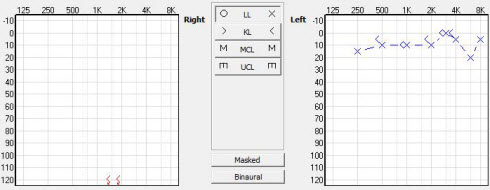
Figure 4. Audiological data for Case Study 1; 34-year old female with unilateral profound hearing loss. Left-ear thresholds are essentially normal, making her a candidate for CROS amplification.
Predicted target gain in the software was about the same as what was measured in the real-ear. It was relatively flat, close to 0 dB. Sounds are neutrally transmitted from the deaf side to the better-hearing side. Performance was checked by using words in noise. Monosyllabic words are presented at 65 dB to the poor side and noise at 60 dB at the better side. Intelligibility in this patient improved from 10 percent in the unaided condition to 60 percent when the CROS was added. When speech was presented at 80 dB with 60 dB of noise, this patient scored 80 percent correct. This is a dramatic improvement in speech intelligibility over the unaided case.
The second case is a 75-year old male (Figure 5). His hearing was influenced by a middle ear surgery at age 25 that caused more permanent damage than good. He continued to suffer from middle ear infections after that. Additionally, he has an age-induced sloping hearing loss on the left side. This patient was also fitted with an audifon via M system with an earmold with a large vent.
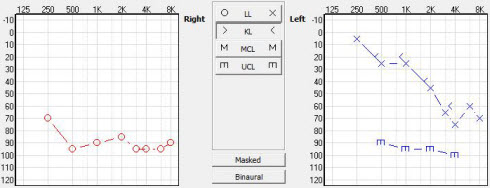
Figure 5. Audiological data for Case Study 2; 75-year old male with severe to profound hearing loss in the right ear and mild sloping to severe hearing loss in the left ear, making him a candidate for BiCROS amplification.
We provided high-frequency amplification in the left ear with more gain for softer input levels than for higher input levels. You would expect the need for some compression according to the hearing loss. We checked performance with speech perception testing, again, using 65 dB speech at the poorer side and 60 dB speech at the better side. In the unaided condition he scored 40 percent correct, which is rather good for this configuration of hearing loss. With the BiCROS device, his score went up to 80 percent for the same signal-to-noise ratio. Scores as high as 80 percent leave little room for improvement due to ceiling effects. In this case, when the speech input was increased to 80 dB, his speech intelligibility did not further improve, but stayed at 80 percent. However, we still see a considerable improvement from 40 percent to 80 percent in unaided versus aided conditions, respectively.
Summary
CROS and BiCROS fittings are a convenient solution for profound hearing loss affecting one ear, or single-sided deafness. The digital, wireless solutions can now solve many of the issues previously present with wired CROS solutions. Fitting CROS and BiCROS devices can easily be done in a few simple steps. Verification of the fitting is essential and should be done in all cases with real-ear measurements. We can use speech-in-noise tests and loudness scaling to prove the performance of the devices. Questionnaires can be used to check overall listening performance in everyday listening situations.
Thank you very much for your participation and attention. We hope to see you again in the near future.
References
Cox, R.M., & Alexander, G.C. (1995). The abbreviated profile of hearing aid benefit. Ear & Hearing, 16(2), 176-186.
Dillon, H., James, A., & Ginis, J. (1997). Client Oriented Scale of Improvement (COSI) and its relationship to several other measures of benefit and satisfaction provided by hearing aids. Journal of the American Academy of Audiology, 8(1), 27-43.
Dillon, H. (2001). Hearing aids. New York: Thieme.
International Organization for Standardization. (2006). ISO 16832: Acoustics- loudness scaling by means of categories.
